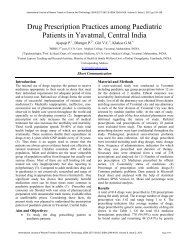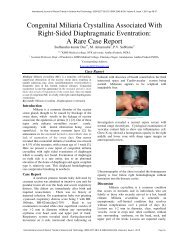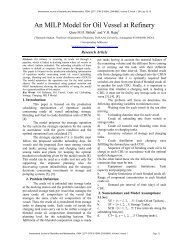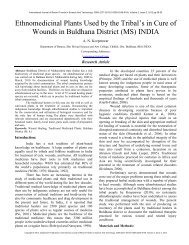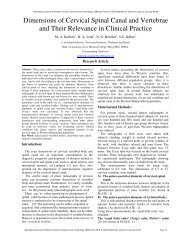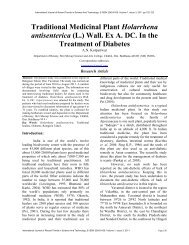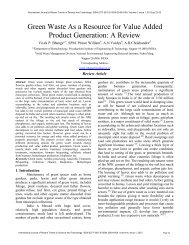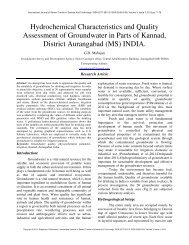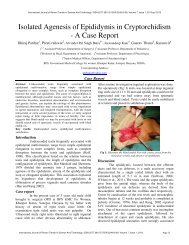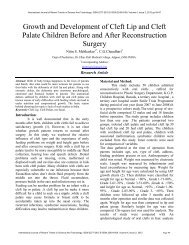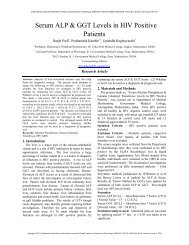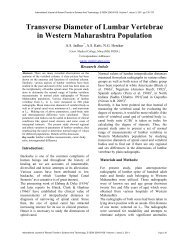Maternal Risk Factors Determining Birth Weight of ... - Statperson
Maternal Risk Factors Determining Birth Weight of ... - Statperson
Maternal Risk Factors Determining Birth Weight of ... - Statperson
Create successful ePaper yourself
Turn your PDF publications into a flip-book with our unique Google optimized e-Paper software.
International Journal <strong>of</strong> Recent Trends in Science And Technology, ISSN 2277-2812 E-ISSN 2249-8109, Volume 5, Issue 1, 2012 pp 03-08<br />
<strong>Maternal</strong> <strong>Risk</strong> <strong>Factors</strong> <strong>Determining</strong> <strong>Birth</strong> <strong>Weight</strong><br />
<strong>of</strong> Newborns: A Tertiary Care Hospital Based<br />
Study<br />
P. S. Thomre 1 , A. L. Borle 1* , J. D. Naik 2 , S. S. Rajderkar 2<br />
1 Department <strong>of</strong> Community Medicine, R. C. S. M. Govt. Medical College, Kolhapur (MS) INDIA.<br />
2 Department <strong>of</strong> Community Medicine, Govt. Medical College, Miraj, Sangli (MS) INDIA.<br />
* Corresponding address:<br />
dramodborle@rediffmail.com<br />
Research Article<br />
Abstract: Introduction: Globally, more than 20 million infants<br />
are born with low birth weight. The number <strong>of</strong> low birth weight<br />
babies is concentrated in two regions <strong>of</strong> the developing world:<br />
Asia and Africa. 72% <strong>of</strong> low birth weight infants in developing<br />
countries are born in Asia where most births also take place, and<br />
22% are born in Africa. India alone accounts for 40% <strong>of</strong> low<br />
birth weight births in Asia. . The reduction <strong>of</strong> low birth weight<br />
also forms an important contribution to the Millennium<br />
Development Goal (MDG) for reducing child mortality. The<br />
factors associated with intrauterine growth retardation are<br />
multiple and interrelated to mother, placenta and foetus.<br />
Objectives: 1) To study the ‘<strong>Birth</strong> weight’ pattern among study<br />
group. 2) To identify the maternal factors associated with low<br />
birth weight <strong>of</strong> newborns. Material and Methods: The present<br />
cross sectional study was carried out in Government Medical<br />
College & Hospital, Miraj amongst all the mothers and newborns<br />
delivered at institution during the period <strong>of</strong> one calendar year<br />
from January 2007 to December 2007. The data was collected<br />
with the help <strong>of</strong> interview technique using predesigned and<br />
pretested questionnaires followed by the thorough clinical<br />
examination and anthropometric measurements <strong>of</strong> mother and<br />
newborn. Interview was followed by thorough clinical<br />
examination and necessary investigations. Results &<br />
Conclusion: Low birth weight was found to be present in 92<br />
(18.1%) newborns. The internal comparison was made among<br />
the study subjects with normal birth weight babies and those with<br />
low birth weight babies using the bivariate analysis and multiple<br />
logistic regressions. The factor found significantly associated<br />
were gestational age at delivery, number <strong>of</strong> antenatal visits,<br />
anemia, gestational age at 1 st ANC visit, bad obstetric history,<br />
mothers weight, socio-economic status, birth interval, type <strong>of</strong><br />
work, iron and folic acid supplementation, religion, sex <strong>of</strong> new<br />
born and gravida.<br />
Key Words: Low birth weight, maternal risk factors, antenatal<br />
care, newborns.<br />
Introduction<br />
Growth <strong>of</strong> the fetus is affected by maternal,<br />
environmental and genetic factors. Intrauterine growth<br />
and development is one <strong>of</strong> the most vulnerable<br />
processes in human life cycle and its aberrations can<br />
result in lasting pr<strong>of</strong>ound influence in later life. In the<br />
context <strong>of</strong> developing countries, intrauterine growth has<br />
been invariably assessed by birth weight. 1 The birth<br />
weight <strong>of</strong> an infant is the single most significant<br />
determinant <strong>of</strong> its chances <strong>of</strong> survival, healthy growth<br />
and development. 2<br />
Low birth weight is one <strong>of</strong> the most serious<br />
challenges in maternal and child health in both<br />
developed and developing countries. Its public health<br />
significance may be ascribed to numerous factors – its<br />
high incidence, its association with mental retardation<br />
and a high risk <strong>of</strong> peri natal and infant mortality (half <strong>of</strong><br />
all peri natal and one third <strong>of</strong> all infant deaths are due to<br />
low birth weight); human wastage and suffering, the<br />
very high cost <strong>of</strong> special care and intensive care unit<br />
and its association with socioeconomic<br />
underdevelopment. 2 Low birth weight is considered as a<br />
sensitive index <strong>of</strong> Nation’s health and development. 3<br />
Early marriages, high work burden, small birth<br />
intervals and discriminatory food customs combine to<br />
place the pregnant women at the risk <strong>of</strong> becoming, or<br />
remaining, malnourished.<br />
Globally, more than 20 million infants are born<br />
with low birth weight. The number <strong>of</strong> low birth weight<br />
babies is concentrated in two regions <strong>of</strong> the developing<br />
world: Asia and Africa. 72% <strong>of</strong> low birth weight infants<br />
in developing countries are born in Asia where most<br />
births also take place, and 22% are born in Africa. India<br />
alone accounts for 40% <strong>of</strong> low birth weight births in<br />
Asia.<br />
The goal <strong>of</strong> reducing low birth weight incidence<br />
by at least one third between 2000 and 2010 is one <strong>of</strong><br />
the major goals in “A world Fit for Children”, the<br />
Declaration and Plan <strong>of</strong> Action adopted at the United<br />
Nations General Assembly Special Session on Children<br />
in 2002. The reduction <strong>of</strong> low birth weight also forms<br />
an important contribution to the Millennium<br />
Development Goal (MDG) for reducing child mortality.<br />
Activities towards the achievement <strong>of</strong> the MDGs will<br />
need to ensure a healthy start in life for children by<br />
making certain that women commence pregnancy<br />
healthy and well nourished, and go through pregnancy<br />
and childbirth safely. Low birth weight is therefore an<br />
Copyright © 2012, <strong>Statperson</strong> Publications, International Journal <strong>of</strong> Recent Trends in Science And Technology, ISSN 2277-2812 E-ISSN 2249-8109, Volume 5, Issue 1, 2012
P. S. Thomre, A. L. Borle, J. D. Naik, S. S. Rajderkar<br />
important indicator for monitoring progress towards<br />
this internationally agreed-upon goals. 4<br />
The factors associated with intrauterine growth<br />
retardation are multiple and interrelated to mother,<br />
placenta and foetus. <strong>Maternal</strong> factors include<br />
malnutrition, severe anemia, heavy physical work,<br />
malaria, toxemia, smoking; low socioeconomic status,<br />
short maternal stature, very young age, high parity,<br />
close birth spacing and low educational status etc.<br />
placental causes include placental insufficiency and<br />
placental abnormalities. The foetal causes include foetal<br />
abnormalities, intrauterine infections, chromosomal<br />
abnormalities, multiple gestations<br />
Thus in view <strong>of</strong> all this the study was designed<br />
with the following objectives 1) To study the ‘<strong>Birth</strong><br />
weight’ pattern among study group. 2) To identify the<br />
maternal factors associated with low birth weight <strong>of</strong><br />
newborns.<br />
Material and Methods<br />
This hospital based cross sectional study was<br />
conducted in Government Medical College & Hospital,<br />
Miraj amongst all the mothers and newborns delivered<br />
at institution during the period <strong>of</strong> one calendar year<br />
from January 2007 to December 2007.<br />
A pilot study was carried out to test the<br />
pr<strong>of</strong>orma and check the feasibility <strong>of</strong> the study. After<br />
the pilot study necessary revisions were made in the<br />
pr<strong>of</strong>orma. Study variables included were birth weight <strong>of</strong><br />
baby, maternal age, religion, occupation and education,<br />
socio-economic status, type <strong>of</strong> residence, type <strong>of</strong><br />
family, mother’s height and weight, parity, interpregnancy<br />
interval, gestational age, number <strong>of</strong> ANC<br />
visits, iron and folic acid supplementation received,<br />
hemoglobin status, nature <strong>of</strong> work during pregnancy,<br />
nutritional intake, bad obstetric history and sex <strong>of</strong> baby.<br />
Low birth <strong>Weight</strong> (LBW) babies were defined<br />
as babies having birth weight less than 2.5 kg. 5 The<br />
birth weight <strong>of</strong> newborn was recorded within 1 hours <strong>of</strong><br />
delivery on electronic weighing machine. Before taking<br />
weight clothes were taken <strong>of</strong>f and zero was confirmed.<br />
Machine was standardized from time to time.<br />
Data Collection:<br />
Ethical clearance was obtained from<br />
the institutional Ethics Committee. The objective <strong>of</strong> the<br />
study was explained to participants and informed<br />
consent was taken. The data was collected with the help<br />
<strong>of</strong> interview technique using predesigned and pretested<br />
questionnaires followed by the thorough clinical<br />
examination and anthropometric measurements <strong>of</strong><br />
mother and newborn. Necessary investigations were<br />
carried out like hemoglobin estimation, urine sugar and<br />
albumin, VDRL and blood group estimation. Interview<br />
was taken on the next day <strong>of</strong> delivery. The available<br />
health records were also reviewed.<br />
Statistical analysis:<br />
For analysis descriptive statistics used were<br />
percentage, mean and standard deviation (SD).<br />
Bivariate analysis was done using crude odds ratio,<br />
95% confidence interval (CI) and chi-square test.<br />
Multiple logistic regressions were used to calculate<br />
adjusted odds ratio.<br />
All the analysis was carried out using SPSS<br />
16.0 and EPI Info 3.5.1.<br />
Results<br />
Out <strong>of</strong> total 524 deliveries only 509 (97%)<br />
could be covered / interviewed and examined and were<br />
included in the analysis. The remaining 15 (3%) could<br />
not be included in the study, due to immediate transfer<br />
<strong>of</strong> patient, non – response <strong>of</strong> the patients, non co–<br />
operation for examination and incomplete information.<br />
Table 1 shows the birth weight pattern <strong>of</strong> total 509<br />
births, 417 (81.9%) newborns were having normal birth<br />
weight while 92 (18.1%) newborns were having low<br />
birth weight.<br />
Table 1: <strong>Birth</strong> weight pattern <strong>of</strong> the newborns<br />
<strong>Birth</strong> weight Total % Mean birth wt.<br />
± S.D.<br />
Normal birth weight 417 81.9 2.87 ± 0.31<br />
Low birth weight 92 18.1 2.14 ± 0.25<br />
Total 509 100<br />
The internal comparison was made among the<br />
study subjects with normal birth weight babies and<br />
those with low birth weight babies using the bivariate<br />
analysis. The Odds ratios were calculated for the<br />
attributes. Table 2 shows the bivariate analysis <strong>of</strong> the<br />
socio demographic factors amongst the study subjects<br />
with normal and low birth weight babies. The factors<br />
which were found to be significantly associated with<br />
low birth weight <strong>of</strong> the newborns were age <strong>of</strong> the<br />
mother at the time <strong>of</strong> conception, type <strong>of</strong> the mother’s<br />
work and socioeconomic status. However religion,<br />
mother’s education, type <strong>of</strong> the residence and the type<br />
<strong>of</strong> family were found insignificant in the present study.<br />
Highest odds was observed for socioeconomic status i.e<br />
5.26 followed by type <strong>of</strong> work (4.37).<br />
Table 2: Bivariate analysis <strong>of</strong> the socio- demographic factors amongst the study subjects with normal and low birth weight babies<br />
Attributes NBW LBW Total p value OR<br />
No. % No. %<br />
(95% CI)<br />
Age <strong>of</strong> Mother in years<br />
< 19 32 69.57 14 30.43 46<br />
0.022 * 0.46<br />
≥ 19 385 83.15 78 16.85 463<br />
( 0.23 - 0.96)<br />
Religion<br />
Hindu 299 81.92 66 18.08 365 0.99 1.00<br />
International Journal <strong>of</strong> Recent Trends in Science And Technology, ISSN 2277-2812 E-ISSN 2249-8109, Volume 5, Issue 1, 2012 Page 4
International Journal <strong>of</strong> Recent Trends in Science And Technology, ISSN 2277-2812 E-ISSN 2249-8109, Volume 5, Issue 1, 2012 pp 03-08<br />
other religions 118 81.94 26 18.06 144 (0.59 - 1.69)<br />
Mother’s Education<br />
Illiterate 56 80.00 14 20.00 70<br />
0.86<br />
0.86<br />
(0.44 - 1.72)<br />
Literate 361 82.23 78 17.77 439<br />
Type <strong>of</strong> Work<br />
Light or Moderate Work 342 87.92 47 12.08 389<br />
Heavy Work 75 62.50 45 37.50 120<br />
Socioeconomic Status<br />
Upper (U + UM+ LM) 112 94.92 6 5.08 118<br />
Lower (UL +L) 305 78.01 86 21.99 391<br />
Residence<br />
Urban 153 83.7 34 16.3 187<br />
Rural 264 82 58 18 322<br />
Type <strong>of</strong> Family<br />
Nuclear Family 104 80.6 25 19.4 129<br />
Joint Family 206 83.7 40 16.3 246<br />
Three Generation Family 107 79.9 27 20.1 134<br />
Total 417 81.9 92 18.1 509<br />
* - significant<br />
< 0.001 * 4.37<br />
(2.63 - 7.25)<br />
< 0.001 * 5.26<br />
(2.14 - 13.76)<br />
0.96<br />
0.58<br />
0.99<br />
(0.60 - 1.62)<br />
Table 3: Bivariate analysis <strong>of</strong> the maternal constitutional and reproductive factors amongst the study subjects with normal and low birth<br />
weight babies<br />
Attributes NBW LBW Total p value OR<br />
No. % No. %<br />
(95% CI)<br />
Mother's Height<br />
< 140 cm 14 93.3 1 6.7 15 0.49*<br />
> 140 cm 403 81.6 91 18.4 494<br />
Mother's <strong>Weight</strong><br />
< 40 kg 16 45.7 19 54.3 35<br />
> 40 kg 401 84.6 73 15.4 474<br />
Sex <strong>of</strong> newborn<br />
Male 240 85.7 40 14.3 280<br />
Female 177 77.3 52 22.7 229<br />
Gravida<br />
1, 172 78.5 47 21.5 219<br />
> 1 249 84.5 45 15.5 290<br />
Gestational age at delivery<br />
< 37 66 45.5 79 54.5 145<br />
≥ 37 351 96.3 13 3.6 364<br />
Inter pregnancy Interval<br />
Fisher<br />
Exact<br />
3.16<br />
(0.43 - 65.24)<br />
< 0.001 * 0.15<br />
(0.07 - 0.33)<br />
0.014 * 1.76<br />
(1.09 - 2.85)<br />
0.072<br />
< 3 332 79.2 87 20.8 419<br />
≥ 3 85 94.4 5 5.6 90<br />
Bad Obstetrics history<br />
Absent 381 88.2 51 11.8 432<br />
Present 36 46.8 41 53.2 77<br />
Iron and folic acid supplementation<br />
Not Received 12 44.5 10 45.5 22 0.002*<br />
Received 405 83.3 82 16.7 487<br />
Anaemia<br />
< 11 gm 110 60.8 71 39.2 181<br />
> 11 gm 307 93.6 21 6.4 328<br />
Gestational age at 1st ANC visit<br />
I st Trimester 324 87.6 46 12.4 370<br />
II nd Trimester 68 72.3 26 27.7 94<br />
III rd Trimester 14 60.1 9 39.1 23<br />
Not registered 11 50 11 50 22<br />
Total number <strong>of</strong> ANC Visits<br />
< 3 13 39.4 20 60.6 33<br />
> 3 404 84.9 72 15.1 476<br />
Total 417 81.9 92 18.1 509<br />
* - significant<br />
0.66<br />
(0.41 - 1.07)<br />
< 0.001 * 0.03<br />
(0.02 - 0.06)<br />
< 0.001 * 0.22<br />
(0.08 - 0.60)<br />
< 0.001 * 8.51<br />
(4.82 - 15.05)<br />
Fisher<br />
Exact<br />
0.24<br />
(0.09 - 0.63)<br />
< 0.001 * 0.11<br />
(0.06 - 0.19)<br />
< 0.001 *<br />
(df =2)<br />
--------<br />
< 0.001 * 0.12<br />
(0.05 - 0.26)<br />
Copyright © 2012, <strong>Statperson</strong> Publications, International Journal <strong>of</strong> Recent Trends in Science And Technology, ISSN 2277-2812 E-ISSN 2249-8109, Volume 5, Issue 1, 2012
P. S. Thomre, A. L. Borle, J. D. Naik, S. S. Rajderkar<br />
Table 3 shows the bivariate analysis <strong>of</strong> the<br />
maternal constitutional and reproductive factors<br />
amongst the study subjects with normal and low birth<br />
weight babies. Mother’s weight, gestational age at<br />
delivery, gestational age at 1 st ANC visit, inter<br />
pregnancy interval, anemia in mother, bad obstetrics<br />
history, and total number <strong>of</strong> ANC visits, Iron and folic<br />
acid supplementation, sex <strong>of</strong> newborn were found to be<br />
significantly associated with low birth weight <strong>of</strong> the<br />
newborns. Comparison was also made between the<br />
mothers with gravida =1 and gravida >1 but it was<br />
found insignificant in the present study. Also mother’s<br />
height was found to be insignificant. Bad obstetrics<br />
history had the highest odds ratio (8.51).<br />
Multiple logistic regression analysis (Table 4)<br />
was done to eliminate the confounders as well<br />
identifying the individual effects <strong>of</strong> the factors.<br />
Table No. 4: Multiple logistic regressions analysis <strong>of</strong> maternal factors associated with low birth weight<br />
Sr.<br />
No.<br />
Variables tested<br />
Adjusted Odds<br />
Ratio<br />
95% Cl. Level <strong>of</strong><br />
significance<br />
1 Gestational age at delivery 32.47 17.06 – 61.81 HS<br />
2 Total no. <strong>of</strong> ANC visits 10.91 4.95 – 24.02 HS<br />
3 Anaemia 9.43 5.45 – 15.86 HS<br />
4 Gestational age at 1 st ANC 8.7 3.66 – 20.74 HS<br />
visit<br />
5 Bad obstetrics history 8.5 4.92 – 14.66 HS<br />
6 Mother’s weight 7.05 3.41 – 14.59 HS<br />
7 Socio-economic status 5.20 2.21 – 12.2 HS<br />
8 inter pregnancy interval 5.11 1.97 – 13.27 HS<br />
9 Type <strong>of</strong> work 4.57 2.80 – 7.54 HS<br />
10 Iron & Folic acid<br />
4.50 1.79 – 11.30 HS<br />
supplementation<br />
11 Religion 3.34 1.67 – 6.69 Sig<br />
12 Sex <strong>of</strong> newborn 1.77 1.12 – 2.80 Sig<br />
13 Gravida 1.70 1.02 - 2.84 Sig<br />
14 Residence 1.18 0.70 - 199 NS<br />
15 Mothers education 1.14 0.59 – 2.21 NS<br />
16 Type <strong>of</strong> family 0.89 0.53 – 1.51 NS<br />
17 Mother’s height 0.31 0.04 – 2.45 NS<br />
* HS- Highly significant, Sig- significant, NS- non significant<br />
Table No. 4 shows that OR is very high for gestational<br />
age at delivery, number <strong>of</strong> antenatal visits, anemia,<br />
gestational age at 1 st ANC visit, bad obstetric history,<br />
mothers weight, socio-economic status, birth interval,<br />
type <strong>of</strong> work, iron and folic acid supplementation.<br />
These factors were found to be highly significantly<br />
associated with the low birth weight. Religion, sex <strong>of</strong><br />
new born and gravida were found to be significantly<br />
associated. While Mother’s education, type <strong>of</strong> family<br />
and mother’s height, and residence were found to be<br />
insignificant.<br />
Discussions<br />
The present study was carried out to assess the<br />
birth weight pattern in study group and to identify and<br />
to assess the impact <strong>of</strong> certain vulnerable factors<br />
influencing the birth weight.<br />
In the present study prevalence <strong>of</strong> low birth<br />
weight was found to be 18.1 %. These findings were<br />
similar to that studied by Kamaladoss T et al (1990) 6 .<br />
Prevalence <strong>of</strong> low birth weight babies was low<br />
as compared to that observed in NFHS -3 (21.5%) 7 .<br />
Deshmukh et al (1994) 8 , Idris MZ et al (2000) 3 , Joshi<br />
SM et al(2000) 9 found very high prevalence <strong>of</strong> low<br />
birth weight babies in their studies i.e. 30.3% , 32.2%<br />
and 32.5% respectively.<br />
Low prevalence <strong>of</strong> low birth weight babies in<br />
present study might be due to the fact that majority<br />
women were registered during pregnancy and they were<br />
availing the antenatal services from Govt. Medical<br />
College hospital and also receiving medicinal<br />
supplement and nutritional education.<br />
In present study factors found to be<br />
significantly related with low birth weight <strong>of</strong> babies<br />
were gestation age at delivery, number <strong>of</strong> antenatal<br />
visits, anemia, gestational age at 1 st ANC visit, bad<br />
obstetric history, mothers weight, socio-economic<br />
status, birth interval, type <strong>of</strong> work, iron and folic acid<br />
supplementation religion, sex <strong>of</strong> new born and gravida.<br />
Anand K et al (2000) 10 observed that lower<br />
socioeconomic status, higher parity, bad obstetrics<br />
history, presence <strong>of</strong> anaemia and antenatal care were<br />
risk factors for the low birth weight <strong>of</strong> babies. Similar<br />
findings were also observed by Mann LI et al (1974) 11 .<br />
Sharma MK et al (2009) 12 and Joshi SM et al (2000) 9<br />
found that lower socioeconomic status was significantly<br />
associated with LBW. Low socio-economic strata were<br />
usually overburdened with work, poor nutritional status<br />
and lack <strong>of</strong> education which could contribute to large<br />
number <strong>of</strong> LBW.<br />
Studies conducted by Mavalankar DV et al<br />
(1992) 13. , Acharya D et al (2004) 14 and Deswal BS et al<br />
(1999) 15 found that maternal constitutional factors like<br />
International Journal <strong>of</strong> Recent Trends in Science And Technology, ISSN 2277-2812 E-ISSN 2249-8109, Volume 5, Issue 1, 2012 Page 6
International Journal <strong>of</strong> Recent Trends in Science And Technology, ISSN 2277-2812 E-ISSN 2249-8109, Volume 5, Issue 1, 2012 pp 03-08<br />
maternal height and weight were significantly<br />
associated with low birth weight <strong>of</strong> babies. In present<br />
study no association was found between maternal<br />
height and birth weight <strong>of</strong> baby which might be due to<br />
less number <strong>of</strong> women having height less than 140 cm<br />
in the study.<br />
Prevalence <strong>of</strong> low birth weight babies was<br />
high in mothers whose age was more than 35 years as<br />
well as less than 19 years as compared to 20 to 34 years<br />
age group. Similar findings were observed by Mukherji<br />
DK et al (1970) 16 , Fedric J et al (1976) 17 , Anand K et al<br />
(2000) 10 .<br />
While Kramer MS (1984) 18 in contrary to our<br />
observations reported two studies with no association<br />
between maternal age and birth weight <strong>of</strong> baby.<br />
High prevalence among < 19 years age groups<br />
could be due to teenage pregnancies, when the growth<br />
is not fully completed. Also marriages at an early age<br />
would lead large no <strong>of</strong> pregnancy with inadequate<br />
spacing contributing for low birth weight.<br />
Similarly women over 35 years <strong>of</strong> age might<br />
exhibit impaired intrauterine growth or inadequate<br />
gestational duration delivering low birth weight babies.<br />
Present study also revealed that the percentage<br />
<strong>of</strong> low birth weight decreases with increasing inter<br />
pregnancy interval. Similar finding were also observed<br />
by Ghosh et al (1969) 19 Das et al (1977) 20 and Deswal<br />
BS et al (1999) 15 in their study. Vijaykumar (1992) 21<br />
revealed that birth interval had a direct relation to birth<br />
weight. In contradictory to above finding Ghate et al<br />
(1993) 22 in their study found no association between<br />
inter-pregnancy interval and low birth weight <strong>of</strong> baby.<br />
Improved maternal health as a consequence <strong>of</strong><br />
prolonged spacing could reflect in having higher birth<br />
weight. On multiple logistic regression it was observed<br />
that gravida >1 and bad obstetrics history was<br />
significantly associated with low birth weight, which<br />
was also confirmed by the findings observed by Anand<br />
K et al (2000) 10 in their studies.<br />
In present study it was found that prevalence <strong>of</strong><br />
LBW babies in mothers whose hemoglobin was less<br />
than 11 gm, was higher as compared to mothers whose<br />
hemoglobin level was more than 11 gm, which was<br />
consistent with the findings observed by Ghosh et al<br />
(1969) 19 Tyagi et al (1985) 23 , Swain et al (1988) 24 , Steer<br />
et al (1991) 25 , Ghate et al (1993) 22 , Grover et al<br />
(1998) 26 and Anand K et al (2000) 10 .<br />
Thus the study finding suggests improving the<br />
utilization <strong>of</strong> ANC services, and improving educational<br />
status <strong>of</strong> women. Also activities to increase awareness<br />
regarding birth spacing and early ANC registration<br />
should be carried out. Health education should be given<br />
to mothers regarding nutrition and iron and folic acid<br />
supplementation. Early diagnosis and proper<br />
management <strong>of</strong> anemia should be done.<br />
Limitations<br />
1. Present study was hospital based study. Not all<br />
sections <strong>of</strong> the community use hospital<br />
facilities. Again government facilities delivered<br />
at free are not used by all sections <strong>of</strong> the<br />
community. So due precaution should be taken<br />
while projecting the study results into the<br />
community.<br />
2. Precise information regarding pre pregnant<br />
weight <strong>of</strong> the women could not be obtained as<br />
majority women are illiterate coming from<br />
rural area and not aware about the significance<br />
<strong>of</strong> weight records.<br />
References<br />
1. Sachdev HPS. Low birth weight in South Asia. Int J<br />
Diab Dev Countries 2001; 21(1):13-33.<br />
2. Park K. Text book <strong>of</strong> Preventive and Social Medicine.<br />
19 th edition. Jabalpur Banarsidas Bhanot Publishers,<br />
2007. p. 426-428.<br />
3. Idris MZ, Gupta A, Mohan U, Srivastava AK, Das V.<br />
<strong>Maternal</strong> health and low birth weight among<br />
institutional deliveries. Indian Journal <strong>of</strong> Community<br />
Medicine.2000; 25(4):156-160.<br />
4. United Nations Children's Fund, World Health<br />
Organization. Low <strong>Birth</strong>weight: Country, Regional<br />
and Global Estimates. New York, NY UNICEF<br />
2004:1- 27.<br />
5. World Health Organization. International Statistical<br />
classification <strong>of</strong> diseases and health problems. 10 th<br />
revision, 2 nd edition, World Health Organization,<br />
Geneva, 2004; 2:136-137.<br />
6. Kamaladoss T, Abel R, Sampathkumar V.<br />
Epidemiological co-relates <strong>of</strong> low birth weight in Rural<br />
Tamilnadu. Indian Journal <strong>of</strong> Pediatrics 1992; 59:299-<br />
304.<br />
7. International Institute <strong>of</strong> Population Sciences, National<br />
Family Health Survey, India. 2005-06 (NFHS-3, Vol.<br />
1) 2007:225.<br />
8. Deshmukh JS, Motghare DD, Zodpe SP, Wadhva SK.<br />
Low birth weight and associated maternal factors in an<br />
urban Area. Indian Paediatrics 1998; 35:33-35.<br />
9. Joshi SM, Pai NP. Effect <strong>of</strong> the maternal Bio-Social<br />
Determinant on <strong>Birth</strong> <strong>Weight</strong> in A Slum Area <strong>of</strong><br />
Greater Mumbai. Indian Journal <strong>of</strong> Community<br />
Medicine 2000; 25(3):121-23.<br />
10. Anand K, Garg BS. A study <strong>of</strong> <strong>Factors</strong> affecting LBW.<br />
Indian Journal <strong>of</strong> Community Medicine 2000;<br />
25(2):57-61.<br />
11. Mann LI, Tejani NA, Weiss RR. Antenatal diagnosis<br />
and management <strong>of</strong> small for gestational age fetus. Am<br />
J Obstet Gynecol 1974;120:995-1004.<br />
12. Sharma MK, Kumar D, Huria A, Gupta P. <strong>Maternal</strong><br />
risk factors <strong>of</strong> low birth weight in Chandigarh India.<br />
Internet J Health 2009: 9.<br />
13. Mavalankar DV, Gray RH, Trivedi CR. <strong>Risk</strong> factors<br />
for preterm and term low birth weight in Ahmedabad,<br />
India. Int J Epidemiol 1992;21:263-72.<br />
14. Acharya D, Nagraj K, Nair NS, Bhat HV. <strong>Maternal</strong><br />
determinants <strong>of</strong> intrauterine growth retardation: a case<br />
control study in Udupi District, Karnataka. Indian J<br />
Community Med 2004;29:181-83.<br />
15. Deswal BS, Singh JV, Kumar D. A study <strong>of</strong> risk<br />
factors for low birth weight. Indian Journal<br />
Community Medicine 1999; 24 (3): 127-131.<br />
Copyright © 2012, <strong>Statperson</strong> Publications, International Journal <strong>of</strong> Recent Trends in Science And Technology, ISSN 2277-2812 E-ISSN 2249-8109, Volume 5, Issue 1, 2012
P. S. Thomre, A. L. Borle, J. D. Naik, S. S. Rajderkar<br />
16. Mukherjee DK, Sethna NJ. <strong>Birth</strong> weight and its<br />
relation with certain maternal factors. Indian J Pediat<br />
1970; 37:460-464.<br />
17. Fedrick J, Adelstein P. <strong>Factors</strong> associated with low<br />
birth weight <strong>of</strong> infants delivered at term. British<br />
Journal <strong>of</strong> obstetrics and Gynaecology 1987; 85(1): 1-<br />
7.<br />
18. Kramer MS. Determinants <strong>of</strong> low birth weight:<br />
Methodological assessment and meta-analysis. WHO<br />
Bull 1987;65(5):663-737.<br />
19. Ghosh S, Hooja V, Mittal SK, Verma RK. Bio-Social<br />
Determinant <strong>of</strong> <strong>Birth</strong> <strong>Weight</strong>. Indian Pediatrics<br />
1977;14(2):107-114.<br />
20. Das K, Ganguly SS, Saha R, Ghosh BN. Interrelation<br />
<strong>of</strong> birth weight with certain biological and Socioeconomic<br />
factors. Indian Journal <strong>of</strong> Public Health<br />
1981;25 (1): 11-19.<br />
21. Vijayakumar K. <strong>Birth</strong> Spacing and its Bearing on <strong>Birth</strong><br />
weight. Indian Journal <strong>of</strong> Community Medicine 1992;<br />
17 (1): 15-20.<br />
22. Ghate MM, Pratinidhi AB, Gupte AM. Effect <strong>of</strong><br />
maternal nutritional status on birth weight <strong>of</strong> the baby.<br />
The Journal <strong>of</strong> obstetrics and Gynaecology <strong>of</strong> India<br />
2001; 51(1): 38-41.<br />
23. Tyagi NK, Bhatiya BD, Sur AM. Low birth weight<br />
babies in relation to nutritional status in primipara.<br />
Indian Pediatrics 1985; 22: 507-514.<br />
24. Swain S, Singh S, Bhatia BD, Pandey S, Krisna M.<br />
<strong>Maternal</strong> hemoglobin and serum albumin and foetal<br />
growth. Indian Paediatrics 1994: 31;778-782.<br />
25. Steer P, Alam MA, Wordsworth J, Wekh A. Relation<br />
between maternal haemoglobin concentration and birth<br />
weight in different ethnic groups. British Medical<br />
Journal 1995; 30: 489-491.<br />
26. Grover V, Agarwal OP, Gupta A, Kumar P, Tiwari RS.<br />
Effect <strong>of</strong> daily and alternate day iron and folic acid<br />
supplementation to pregnant females on the weight <strong>of</strong><br />
newborn. Indian Journal <strong>of</strong> Community Medicine<br />
1998;23 (4): 165-168.<br />
International Journal <strong>of</strong> Recent Trends in Science And Technology, ISSN 2277-2812 E-ISSN 2249-8109, Volume 5, Issue 1, 2012 Page 8



